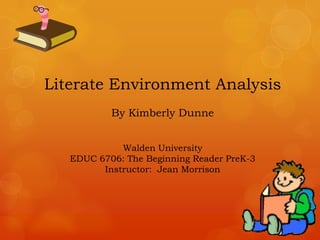
Dunne k literatepresentation
- 1. Literate Environment Analysis By Kimberly Dunne Walden University EDUC 6706: The Beginning Reader PreK-3 Instructor: Jean Morrison
- 2. Creating a Literate Environment Literacy is a process that begins in infancy and continues into adulthood, if not throughout life (Tompkins, 2010, p. 11). Getting to Know Literacy Learners Selecting Texts Literacy Lesson: Interactive Perspective Literacy Lesson: Critical and Response Perspective
- 3. I. Getting to Know Literacy Learners Initially, teachers can get to know their students strengths and areas in need of improvement through formal and informal reading assessments. Cognitive Assessments (i.e. Developmental Reading Assessment) identifies students’ independent, instructional, and frustration reading abilities (Afflerbach, 2012). This information is used to design lessons that meet the specific needs of students within a diverse classroom. Noncognitive Assessments (i.e Interest Inventories, Motivation to Read Profile) provide educators with information about students’ attitudes towards reading, their likes and dislikes, and special interest areas that will aide when selecting texts for a variety of students.
- 4. I. Getting to Know Literacy Learners (cont.) “Teachers who make use of reading inventories are given an assortment of information about their students’ literacy likes and dislikes, as well as reading performance and growth” (Afflerbach, 2012) It is the educator’s responsibility to ensure that the literacy environment fosters a student’s growth in their literacy skills (Laureate Education, Inc., 2011a). “Assessment that helps us understand and appreciate the diverse growth that students experience and the reading challenges they face must be a priority in the classroom” (Afflerbach, 2012).
- 5. II. Selecting Texts It is essential to choose appropriate texts to use within the classroom for instruction as well as independent reading. The right text helps students’ to grasp what is being presented and read. Students eventually shift from learning to read to reading to learn. In order to gain and construct meaning from text, it must meet the interest and instructional levels of the students. The Literacy Matrix is a useful tool to use when selecting text for lessons and individual students: Linguistic (words) Narrative Informational Semiotic (pictures)
- 6. II. Selecting Text (cont.) Research shows that students who are exposed to a selection of texts at an early age will show development at a more rapid rate in obtaining literacy skills (Tompkins, 2010). When selecting text, teachers must consider length, readability, and structure to ensure that it is appropriate and accessible to a group of learners (Laureate Education, Inc., 2011b)
- 7. III. Interactive Perspective of Literacy Teaches students how to read and be strategic processors of information. Goal is to improve students’ metacognitive skills, or how they think about what they are reading (Tompkins, 2010). Students must be taught comprehension strategies as well as basic reading and decoding skills in order to become well-rounded and successful readers. Strategic processing consists of: Phonics Phonemic Awareness Fluency Comprehension Vocabulary
- 8. III. Interactive Perspective of Literacy (cont.) *Activity #1: Used the informational text, Oil Spill! (Berger, 1994), to demonstrate to students how to use post-it notes to record their thinking about the text. Modeled how to record wonderings, reactions, and any other thoughts/questions about the text in order to monitor how they were thinking about what they were reading. *Activity #2: Students independently read the narrative text, Oliver and the Oil Spill (Chandrasekhar, 1991), to practice decoding and fluency skills as well as record their thinking on post-it notes. Students were individually selected to read aloud a page or two to check for word accuracy and understanding. *Activity #3: Web exploration of National Geographic Kids site to research additional information on oil spills and their effects on wildlife. Students were given the opportunity to view videos, photos, and text. The text-speech feature was enabled so that the students could access fully access the content.
- 9. IV.Critical and Response Perspective of Literacy The purpose of critical perspective of literacy learning is to challenge students to think deeply about they read. Students learn to apply critical thinking to validate the text (Laureate Education Inc., 2011c). The purpose of the response perspective of literacy learning is to allow students the opportunity to interact and transact with the text to actively engage with the reading experience (Laureate Education Inc., 2010c). Response to text can take many forms such as journaling, dramatic reenactment, and art.
- 10. IV.Critical and Response Perspective of Literacy (cont.) *Activity #1: Students revisited a familiar text from the previous week, Oliver and the Oil Spill. While reading the text, they completed a Bookmark activity and choose an interesting and confusing part, an important word in the text, and text feature that helped them understand the book better. They had the chance to share with their bookmarks and thinking with their peers. *Activity #2: Students used the text, Oliver and the Oil Spill, to determine Theme. The 6 themes that second graders closely study were presented and reviewed. The students worked collaboratively to determine one(s) was contained in the text. They had to provide examples from the story to support their decisions. *Activity #3: Students returned to the National Geographic website to explore children’s blogs about oil spills. They had the chance to respond to a blog.
- 11. References Afflerbach, P. (2012). Understanding and using reading assessment, K–12 (2nd ed). Newark, DE: International Reading Association. Berger, M. (1994). Oil spill. New York, NY: HarperCollins. Chandrasekhar, A. (1991). Oliver and the oil spill. Kansas City, MO: Landmark Editions, Inc. Laureate Education, Inc. (Producer). (2011a). Getting to know your students. The Beginning Reader Prek-3. Baltimore, MD: Author. Laureate Education, Inc. (Producer). (2011b). Analyzing and selecting text. The Beginning Reader Prek-3. Baltimore, MD: Author. Laureate Education, Inc. (Producer). (2011c). Critical and response perspective. The Beginning Reader Prek-3. Baltimore, MD: Author. Tompkins, G. E. (2010). Literacy for the 21st century: A balanced approach (5th ed.). Boston: Allyn & Bacon.